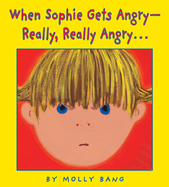The Hurt
by Teddi Doleski

This is from 1983, and you can tell. But despite the simple, 80's-ish illustrations (which are actually great, just a little dated), this is one of my favorite children's books about dealing with emotions. Justin's friend calls him a name, and it makes him feel hurt. The Hurt becomes a physical thing, a round ball with a sad face, that he carries home with him. As he feels worse and worse, the hurt grows larger and larger, and he has to figure out how to get it to go away. I love the conversations he has with his dad, and the gloomy expression on The Hurt's face. And I can totally relate to the feeling of carrying around a big sad thing wherever you go.
When Two Are Angry At Each Other
by
 Tor Age Bringsvaerd, Illustrated by Tina Soli
Tor Age Bringsvaerd, Illustrated by Tina SoliI just found this on the shelf and it got this whole post rolling. Any book with underpants on the front has to be good (Henrietta There's No One Better is another example), and this doesn't disappoint. The narrator tells us that sometimes she and her mommy get angry at each other and then make up, and then goes on to talk about what happens when other things are angry at each other. “When two dragons are angry at each other... smoke comes out of their behinds.” Don't you want to know what happens when two raisins are angry at each other? Balloons? Angels?
When Sophie Gets Angry- Really, Really Angry...

By Molly Bang
This is a Caldecott honor book, and a classic. Bright illustrations show exactly what the title leads you to expect. So what happens, when Sophie gets so angry? Well, a lot of things. For example, “she kicks. She screams. She wants to smash the world to smithereens.” Later, “she runs and runs and runs until she can't run anymore. Then, for a little while, she cries.” Aww, Sophie. Me too.
Andrew's Angry Words
By Dorothea Lachner, Illustrated by Thé Tjong-Khing
As someone who works with people all day, I really understand how we can pass bad moods onto others. When someone says something rude to you, don't you sometimes, accidentally, pass it on to the next person? It's terrible, but I
 can't always shake off the icky feeling, and this book is all about Andrew's angry words getting passed on from his sister to the baker's son, from the baker's son to a poet, from the poet to a passing motorcyclist... and on and on and on. Poor Andrew tries to catch them, but they seem to take on a life of their own. I often imagine the illustrations from this when I'm trying to Be The Bigger Person. Be the person who puts all the words in a sack and throws them in the ocean, I think.
can't always shake off the icky feeling, and this book is all about Andrew's angry words getting passed on from his sister to the baker's son, from the baker's son to a poet, from the poet to a passing motorcyclist... and on and on and on. Poor Andrew tries to catch them, but they seem to take on a life of their own. I often imagine the illustrations from this when I'm trying to Be The Bigger Person. Be the person who puts all the words in a sack and throws them in the ocean, I think.Big Rabbit's Bad Mood
By Ramona Bădescu, Illustrated by Delphine Durand
This is a newe
 r title, and we all adore it. Rabbit's Bad Mood sits around his house all day, watching TV, picking his nose and piling boogers near the couch, bringing down the mood all over Rabbit's house. This is one where the illustrations are the best part, and they are not to be missed.
r title, and we all adore it. Rabbit's Bad Mood sits around his house all day, watching TV, picking his nose and piling boogers near the couch, bringing down the mood all over Rabbit's house. This is one where the illustrations are the best part, and they are not to be missed.I hope I don't need to write up a review of it, but just take this moment to ask yourself, “When was the last time I read Alexander and the Terrible, Horrible, No Good, Very Bad Day?” If it's been awhile, then stop by some time to read it. It never goes out of style.
Anna
